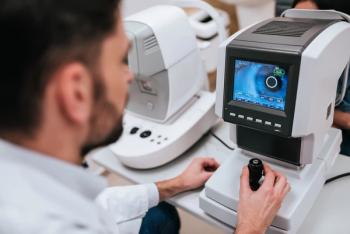
- Vol. 11 No.6
- Volume 11
- Issue 6
How to overcome the challenges of practice transitions
Previously in “
After approaching his associates with a fair market offer for his practice shares, he was surprised they declined the offer, stating they did not see the value in buying the practice.
This conundrum of how to transition out of a practice is increasingly challenging for some ODs, while many younger colleagues are simultaneously seeking private practice opportunities.
With a growing number of successful older practices simply being shuttered, let’s continue to tackle the question of why private practice transitions can be so challenging.
The American Optometric Association’s (AOA)
• 27 percent of ODs have been in practice more than 30 years
• 58 percent of ODs provide care in private practice
Given the aging provider population and large percentage of ODs in private practice settings, this topic is increasingly more relevant.
In this final installment of a three-part series, we will consider the traditional sale of a practice from one doctor to another.
Read the first installment:
Transition timeline
Transactions of this type can sometimes take three to five years-from beginning to consummation, so be sure to plan accordingly.
Also consider whether the seller prefers to sign on the dotted line, hand over the keys and walk away, or if there is an option for the new owner to “buy out” over time with cash or sacrificed earnings with a transitionary period during which the seller stays on to see patients. If the latter, how will compensation and benefits be structured?
Buyer profile
Does the seller prefer a new/recent graduate, an established associate, or a current practice owner? Someone native to the area or with local connections?
There may also be the possibility of bringing someone on for a trial associateship to determine if such a transaction is a good fit. There is no right or wrong answer, but if there is a preference, it may change how to proceed in the next step.
Also by Dr. Wroten:
Identifying/recruiting a buyer
Consider seeker postings on job boards, such as the
Other lead sources include state association executive directors, state regulatory boards (if they are willing to share their list of new licensure applicants), and faculty at the schools and colleges of optometry.
If planning early enough, an OD could recruit a future buyer from his current high school/college student patient base by encouraging them to consider optometry as a career-don’t roll your eyes, it has happened more often than you would expect.
Lastly, do not overlook the resources a practice transitions consultant or headhunting firm may offer for finding a buyer or a seller.
Related:
While there is a fee associated with practice transition consultants that can be negotiated up front, the knowledge and experience they can bring to the table can save time, frustration, and money in the long run-just be sure to ask if they have experience in eye care.
According to Bill Nolan, executive vice president of Williams Group,
Earnings may be obvious-the more the better-but the amount of free cash flow (the cash that a company is able to generate after spending the money to maintain or expand its asset base) is also another general gauge for practice value.
Related:
This differs from net income-the company’s profit, calculated by taking practice revenues and subtracting the costs of doing business (such as depreciation, interest, taxes, and other expenses).
These concepts lead to the four generally accepted practice appraisal methods in current use today:2
• Assets and earnings: Valuation based on hard assets, good will, inventory, and supplies
• Capitalization of earnings: An investment model with a capitalization rate of typically 15 to 20 percent
• Discounted free cash flow (DFCF): Values free cash flow over time, considering the practice as an income-producing business
• Debt service: Valuing the practice’s ability to service its debt
Related:
Transition team
Consider utilizing your certified public accountant (CPA), a labor attorney, a practice transitions consultant, and-depending on the specifics of the transaction-an experienced banker/financial advisor to guide the decision-making process.
Financing the deal
Self-funding a transaction-as opposed to a buyer seeking an external source of funding-can be attractive to both parties by reassuring the buyer of the seller’s extended good will for the practice’s success. It also generates sustained interest earnings and tax breaks for the seller.
Related:
Regardless of which funding mechanism is used, remember: Anything an OD can reasonably do to promote the new owner and help his former practice succeed will make the practice a more attractive option to buyers and therefore benefit both parties. A financial advisor, CPA, and consultant can guide an OD through this process and explain the financial and tax implications.
Other considerations
Will equipment and/or the land and building be part of the sale? When an OD sells the practice, he also needs to remember that he is no longer the owner. Let the new owner run things the way she wants to, offer advice only if asked.
There is much to consider when it comes to any practice transition. With proper planning, an OD can avoid becoming overwhelmed-as long as he does not procrastinate.
As Benjamin Franklin once said, “If you fail to plan, you are planning to fail,” so start planning now for a successful practice transition.
References:
1. American Optometric Association. 2017 AOA Survey of Optometric Practice: Practicing Optometrists and their Patients. Available at: https://www.aoa.org/Documents/2017_Practicing_ExecutiveSummary.pdf. Accessed 5/8/19.
2. Nolan B. How to assess the value of an optometric practice you want to purchase. Williams Group. Available at:
https://www.thewilliamsway.com/assess-the-value-of-an-optometric-practice/. Accessed 5/8/19.
Articles in this issue
over 6 years ago
Pros and cons of mobile optometryover 6 years ago
How artificial intelligence is changing the future of optometryover 6 years ago
I just graduated from optometry school…now what?over 6 years ago
Zoom out to expand treatment for diabetes patientsover 6 years ago
Vision loss diagnosis presents potential complicationsover 6 years ago
3 mental heath conditions to watch for in patientsover 6 years ago
Case report: Don’t be misled by diabetic retinopathyover 6 years ago
Why ODs shouldn’t stop short with patient careover 6 years ago
Everyone tries to figure out health careNewsletter
Want more insights like this? Subscribe to Optometry Times and get clinical pearls and practice tips delivered straight to your inbox.








































